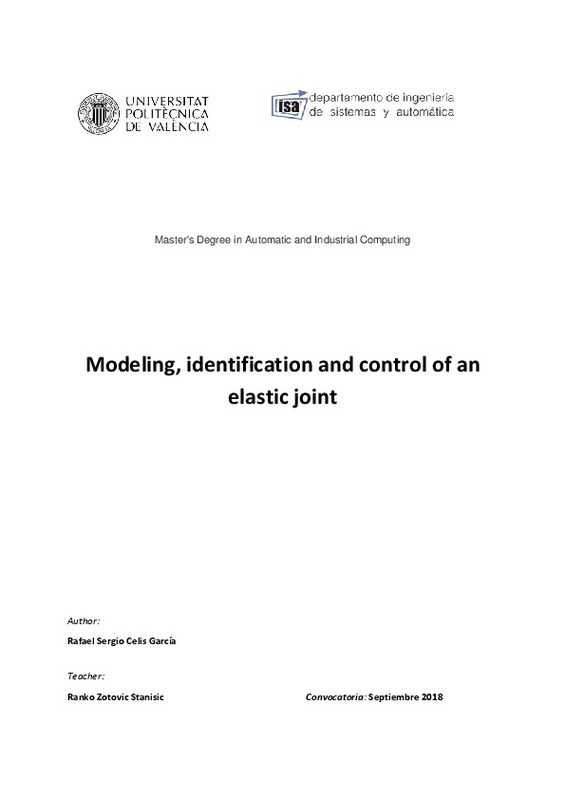JavaScript is disabled for your browser. Some features of this site may not work without it.
Buscar en RiuNet
Listar
Mi cuenta
Estadísticas
Ayuda RiuNet
Admin. UPV
Modelado, identificación y simulación de articulaciones elásticas
Mostrar el registro sencillo del ítem
Ficheros en el ítem
| dc.contributor.advisor | Zotovic Stanisic, Ranko
|
es_ES |
| dc.contributor.author | Celis García, Rafael Sergio
|
es_ES |
| dc.date.accessioned | 2019-01-15T07:31:10Z | |
| dc.date.available | 2019-01-15T07:31:10Z | |
| dc.date.created | 2018-09-26 | |
| dc.date.issued | 2019-01-15 | |
| dc.identifier.uri | http://hdl.handle.net/10251/115461 | |
| dc.description.abstract | En los robots colaborativos y portátiles se utilizan transmisiones mecánicas más ligeras que las convencionales. Sin embargo, ellas conllevan el problema de la elasticidad. En este trabajo se pretende entender bien todos los fenómenos físicos que aparecen, modelarlos, identificarlos e implementar un control mejorado. | es_ES |
| dc.description.abstract | Nowadays the use of harmonic drive systems has become common because its high reduction ratio and high torque transmission in a compact mechanism, especially in robotics where the weight of the robot it¿s an important factor, lower weight transmission with high torque means less energy is spent for operation. On the other hand, the harmonic drive transmissions have more complex dynamic behaviour than conventional gear transmissions. In this project, an experimental platform has been set up in order to analyse the behaviour of the polymeric low cost Harmonic Drive transmission that will be integrated into the joints of the WRAD robot, a prototype developed in previous projects to assist disabled persons. The first part of the project is focused on the experimental platform materials used as the BLDC Motor, the ESCON power stage and the Discovery board mainly. Its configuration as well as the connections and building in order to acquire data from the real system are explained. After that, the different mathematical models that have been researched in the last years are studied in order to integrate them in a Grey-box model to identify the parameters. Finally, the results are tested under simulation and results between the simulations and the real data are compared as well as the difference between models. The mathematical modelling of the Harmonic Drive transmission is reviewed, from the most simple to the most complex model containing nonlinear friction, hysteresis and non-linear cubic elasticity, this will allow in the final part of the project to compare the results obtained and integrated in those models. As long as the project is developed in a low cost prototype platform some limitations were found while working with the system in order to achieve the goals proposed, this limitations would have a repercussion on later results, anyway most of them are solved or treated to reduce its impact in the project. All the process involved in the data acquisition with the Discovery STM32F4 board will be explained together with the signal processing applied before the identification procedure where different models are identified, from the most basic to the most complex with non-linearities, which allows comparing the accuracy of the different models. In order to simplify the identification task, some parameters are estimated from different experiments designed to appreciate the physical phenomena in the data taken. This will be useful in order to reduce the number of parameters being identified, which might lead to bad model identification due to local minima. In addition, the different methods for prediction error minimization used by the matlab functions are explained, and then the model is estimated in steps according to different data sets of the same system with different inputs. The parameters obtained in the identification will be simulated with the models studied and according to the results obtained the parameter variation will allow us to study how it affects the response of the system, this will be important for later conclusions. In addition, the models that have not been identified will be simulated, as well as the effect of the variation of the parameters in the model. | en_EN |
| dc.language | Español | es_ES |
| dc.publisher | Universitat Politècnica de València | es_ES |
| dc.rights | Reconocimiento - Compartir igual (by-sa) | es_ES |
| dc.subject | Robot | es_ES |
| dc.subject | elasticidad | es_ES |
| dc.subject | harmonic drive | es_ES |
| dc.subject | modelado no-lineal | es_ES |
| dc.subject | identificación no-lineal | es_ES |
| dc.subject | BLDC motor | en_EN |
| dc.subject | Elastic robot joint | en_EN |
| dc.subject | Identification | en_EN |
| dc.subject | Grey-box modelling | en_EN |
| dc.subject | Matlab IDNLGREY | en_EN |
| dc.subject | Discovery STM32F4. | en_EN |
| dc.subject.classification | INGENIERIA DE SISTEMAS Y AUTOMATICA | es_ES |
| dc.subject.other | Máster Universitario en Automática e Informática Industrial-Màster Universitari en Automàtica i Informàtica Industrial | es_ES |
| dc.title | Modelado, identificación y simulación de articulaciones elásticas | es_ES |
| dc.type | Tesis de máster | es_ES |
| dc.rights.accessRights | Abierto | es_ES |
| dc.contributor.affiliation | Universitat Politècnica de València. Servicio de Alumnado - Servei d'Alumnat | es_ES |
| dc.contributor.affiliation | Universitat Politècnica de València. Departamento de Ingeniería de Sistemas y Automática - Departament d'Enginyeria de Sistemes i Automàtica | es_ES |
| dc.description.bibliographicCitation | Celis García, RS. (2018). Modelado, identificación y simulación de articulaciones elásticas. http://hdl.handle.net/10251/115461 | es_ES |
| dc.description.accrualMethod | TFGM | es_ES |
| dc.relation.pasarela | TFGM\92407 | es_ES |






